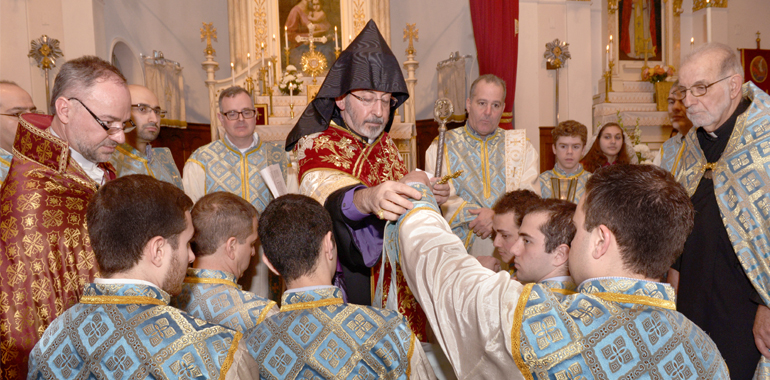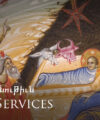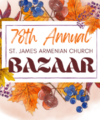
The Church is an organized society. It is composed of all the baptized persons who are united in the same Faith, the same Holy Communion, the same Sacraments, and under the same Ecclesiastical authority. Those who exercise this ecclesiastical authority form the clergy of officers of the Church who serve God, teach and sanctify the faithful, and govern the Church. This authority to serve, to teach, to sanctify and to govern is not given by election or appointment, but by a sacred sacrament called ordination.
Ordination of the Holy Orders is one of the important sacraments of the Church. Through ordination, men receive the power and grace to perform the sacred duties of a clergyman of the Church. Ordination is a sacrament by which the Holy Spirit offers the elected person the right to perform the sacraments and to feed Christ’s flock.
It is true that by Baptism all Christians are endowed with the "priesthood" of laymen, who have thus the obligation to offer up to God the spiritual sacrifices of thanksgiving, prayers and acts of faith, hope, and charity. But only those men who receive the sacrament of the Holy Orders are clergyman of God in the full sense of the word.
The Sacrament of Ordination is always administered by a Bishop. There are various ranks of clergy within the Church, and consequently, there are various services by which each one of these ranks is granted. However, the one act that is common to all the ranks is the "Laying of the hands" (Tzernatroutiun in Armenian) by the Bishop. By placing his anointed right hand on the ordinate, this continues the unbroken Apostolic succession of authority, granted by the apostles to the first Bishops of the Church, and carried on today through Ordination.
For the ordination of any cleric, except a bishop, one bishop is sufficient to administer the Sacrament. The consecration of a Bishop, according to the rules of the Armenian Church, is performed by His Holiness the Catholicos, having at least two other Bishops assisting him at the Ordination. The consent of the laity is expressed formally at the service of Ordination by the choir when they sing: "He is worthy".
Before entering the major ranks of ecclesiastical order of the Armenian Church, a person must have been ordained to the four minor ranks.
Minor Orders
One who receives these four minor ranks is known as a Tbir (or clerk). Through the minor orders, the Tbir is conferred special privileges which are the foundation of his service to the church as a participant during the worship services. There are four distinct functions of a Tbir:
Doorkeeper (Trnaban)
Reader (Untertsogh)
Exorcist (Yertm’netsootsich)
Candle Bearer (Momagal)
In receiving these ranks, one becomes an Acolyte (Pokhasats).
The requirements for ordination to the sub-Diaconate are extensive. The candidate should already have received the minor orders before receiving the rank of sub-Deacon. There are some responsibilities that a sub-Deacon may share with a full deacon; however there are limitations to his responsibilities and authority because this office does not reflect the fullness of one who has become a deacon. The sub-Diaconate is a transitional rank between Tbir and full Deacon in which a young man is preparing himself for fuller service to the church.
Ecclesiastical Orders (Major Orders)
In the beginning the Apostles were the sole ministers in the Church. They were teachers, sanctifiers and rulers in the Church. They even saw to the material needs of the faithful. However, as the membership of the Church increased, the Apostles created other officers to assist them. The first order thus established was that of Deacon. The first deacons were elected by the faithful and were appointed and ordained by the Apostles to distribute aid, as well as to serve the public dinner tables at which Holy Communion was administered (Acts 6:1-7). At present Deacons assist the Bishop and priest in the Church during celebration of the Divine Liturgy, by singing, censing and bringing the gifts to the Holy Altar.
The Apostles also chose, appointed and ordained other assistants to help them in baptizing the converts, in administering the Holy Communion and for other functions in the Church. These men were called Elders. They were the predecessors of our present day priests.
The Priests administer all the sacraments except the Holy Orders and are the shepherds and the leaders of the local churches under the bishop. In the Armenian Church, the priest receives his authority from a Bishop through ordination and anointment with the Holy Chrism (Muron). During the sacrament of ordination to the priesthood the bishop places his hand on the head of the candidate. This is called ordination or cheirotonia. The sacrament of ordination takes place during the Divine Liturgy. The bishop, while clothing the candidate with priestly vestments, anoints with chrism his forehead and palms in the form of the cross.
The Apostles did not stay permanently in a town or country. They were ordered by our Lord to go to all parts of the world to preach the Gospel. Therefore, before leaving a town or country, where they had already established a flourishing church, they used to appoint an able and dependable person to supervise the Christian communities of the area to act with full authority in the name of the Apostles. These men were the successors to the Apostles in their own locality, such as a large town, a province, or even a state. They were called Bishops, Episcopos, which is a Greek word meaning "overseer".
Bishops, with the full power of the Apostles, are the governors of various Diocese of the Church. They alone administer the Holy Orders. According to the canons of the Armenian Church, Bishops alone are authorized to consecrate churches, altars and baptismal fonts. In the Armenian Church the bishop is ordained and anointed by the Catholicos of All Armenians at the Mother See of Holy Etchmiadzin. During the ordination, the bishop receives an Episcopal staff and a ring as signs of his authority. Typically, bishops are elected from among those celibate priests who have achieved the rank of Archimandrite (Vardapet).
The higher ranks are those of Archbishop, Patriarch and Catholicos. They have higher authority and jurisdiction in administrative matters.
In its proper and ancient meaning, the Archbishop was a prelate who had other suffragan bishops to assist him in governing his diocese.
Greeks use the word Metropolitan instead of Archbishop. At present, in the Armenian Church "Archbishop" is an honorary title given by His Holiness the Catholicos to those bishops who are distinguished by their position or good works. Archbishops are consecrated by the Catholicos of All Armenians, and their rank is awarded through Pontifical Encyclical.
The office of Patriarch is the highest in the Greek Church. In the Armenian Church however, the Patriarch is an archbishop who has been elected to serve as the Patriarch of one of the historical patriarchal Sees of Jerusalem or Constantinople. Patriarchs are independent in all administrative matters within the areas of their own jurisdiction.
The office of Catholicos of All Armenians is the highest office in the Armenian Church. The Catholicos of All Armenians is the spiritual leader of the worldwide Armenian Church. The term "Catholicos" is a Greek word meaning General. The Catholicos is typically chosen from the College of Bishops, and once elected is regarded as the "First Among Equals." Twelve bishops consecrate the Catholicos.
Titles within the Ranks of Clergy
Upon their Ecclesiastical Ordination, all clergy are bestowed the title of Priest (Kahana). Depending upon the personal decision of the Priest, he may continue on in rank.
If a Priest decides to be celibate and dedicate his entire life to the Church, he becomes a Monk (Apegha). He declares a vow of celibacy the same evening on the day of his ordination and is given a Cowl (veghar), a special head-cover, which symbolizes his renunciation of worldly things.
After receiving the necessary level of higher education and upon successful completion and defense of a written thesis, on a topic of his choosing, the Monk receives the rank of Archimandrite (Vardapet). This indicates that he is a "Doctor" of the Church and receives the right to carry the staff of an Archimandrite. When an archimandrite receives a scholarly degree, he also receives a staff with a two-headed serpent, which symbolizes wisdom and authority to teach and to preach. This is equal to a Masters of Divinity Degree.
Senior Archimandrite (Dzayrakoun Vartabed) is a title given to those priests who have distinguished themselves by their learning in the fields of theology, religious teaching, and Holy Scriptures, etc and have successfully completed and defended a Doctoral Thesis. It corresponds to Doctor of Divinity in the Western Church. This rank can only be granted by Bishops who themselves have attained the rank of Senior Archimandrite.
The Primate of a Diocese (Arachnort) is a high ranking clergyman who holds the highest position of authority in a given diocese. He may have a lower rank than that of a Bishop, and even if there are retired bishops or even archbishops in his diocese, they come under his jurisdiction in matters of administration.
Archpriest (Avak Kahana) is an honorary title given to those married priests who have fruitfully served their church for long years or who have distinguished themselves in outstanding service to the Church.
"I remind you to rekindle the gift of God that is within you through the laying of my hands," writes St. Paul to his disciple Timothy. (2 Tim 1:6). The ‘Gift" of the Grace which is given to clergy at Ordination is the spiritual authority to fulfill all his duties worthily and in a manner pleasing to God, and to live a virtuous life in conformity with his calling.
People may devote themselves to the service of the Church not only by entering Holy Order, but also in the lay states. The latter service is sometimes as valuable and meritorious before God as the service rendered by the Holy Orders.
source: www.armenianchurch.org



